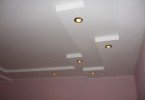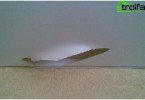False Ceiling Design Options
The ceiling in the apartment has long been not perceived by us as an exceptionally flat white plane. Ceiling structures made of wood, metal, plastic, drywall with various shapes, colors, textures not only allow you to hide all ceiling communications out of sight, but also decorate, transform, surprise and endlessly please … Here’s just how to choose your own, unique option from a variety of possible arrangement of the ceiling? It’s not so simple to think over, comprehend design features, commensurate with the possibility of implementation in the conditions of your own apartment … Let’s look at ready-made examples of how the design of suspended ceilings can be implemented, as well as the necessary conditions for the implementation of the plan.
Content
- Varieties of False Ceilings
- Solid overhead structures
- Modular False Ceilings
The suspended ceiling is a prefabricated structure of the suspension system and cladding blocks, which determine the appearance of the finished ceiling. Let’s start with the undeniable advantages of all suspended structures: they allow you to hide the shortcomings of the base ceiling, improve the sound insulation of the room. In the overhead space, you can place wiring for lighting, alarm, ventilation equipment, computer wiring. These communications can be easily accessible provided that a structure is created that makes it easy to remove and insert individual elements (rails or panels) into place. The advantage of the suspended structure can be simultaneously considered as a disadvantage: with a small room height, the structurally necessary reduction in height will significantly affect the overall perception of the interior.
Varieties of False Ceilings
Suspended ceiling structures are classified depending on the material of the facing elements, design features of the suspension system and functional purpose..
Solid overhead structures
The main difference between continuous suspended ceilings is that they are made of sheet material, it needs to be pre-set to the required size and shape, then properly decorated. The most common material for continuous suspended ceilings is drywall sheets. If the niches between the base and suspended plasterboard ceilings are used to hide communications, then access to them will require the installation of a special hatch.
A decorative suspended ceiling can be suspended under the plane of the main ceiling or act as a complement to another exactly the same (multi-level structures). Design of suspended plasterboard ceilings can be implemented using various materials and technologies: in combination with a stretch ceiling, built-in LED lighting, various decorative elements.
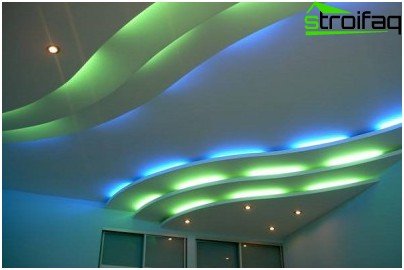
Layered plasterboard ceiling with integrated LED backlight
Plasterboard designs can be of any shape and color, complemented by various decorative details, which opens up new possibilities for correcting “architectural flaws” – not too convenient layout. The rounded shape (spiral, oval) attracts attention, makes the ceiling visually higher (provided that the color scheme of the ceiling is much lighter than the tone of the walls).
Molding is a decorative element that imitates stucco molding. Various wall corners – multi-stage and patterned, installed around the perimeter of the room or in a separate part of the suspended structure – in tone with the main color or contrasting, with gilding give the suspended ceiling made of drywall completeness, a certain stylistic accent. Available in the form of a patch strip or corner.
Modular False Ceilings
They are a variety of suspended structures, where the visible surface is formed by ready-made modules (square or rectangular panels, rails, cassettes). Modules for decorative ceilings can be made from reinforced gypsum, mineral fiber boards, MDF, plastic, metal, drywall, wood.
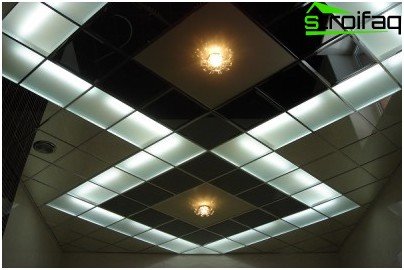
Modular ceiling with integrated lighting: the presence of different modules in terms of color and structure allows you to create many unique options
The use of one or another type of modules or solid material largely depends on the stylistic orientation of the interior.
Hi-tech ceiling design
In the “high-tech” style, gypsum stucco molding or wood panels with beautiful natural patterns are inappropriate, but the severity of the forms of a monochromatic multi-level design with the appropriate lighting style or the cold shine of the ceiling from metal battens perfectly blend into the interior with “industrial aesthetics”.
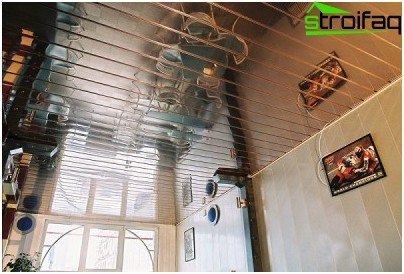
Hi-tech rack ceiling: a combination of luxury and aristocratic laconicism
The impeccability of the form and texture of architectural details is emphasized by laconic decor (plafonds of uncomplicated forms, halogen lamps built into the suspended structures). In the design of the ceiling, made in the style of hi-tech, most often there is a white, gray color or a mirror surface formed by modular elements.
Rococo ceilings
Plaster stucco molding is a place in the Rococo style room: gilding, bizarre curls of floral ornaments, convex shields, various interlacing of patterns on the ceiling will set the tone. The desired shape of the ceiling (preferably round or oval) is created using a multi-level construction of drywall and polyurethane trim (moldings).
A monophonic rococo ceiling is usually abundantly decorated with decorative elements; a semicircular transition from walls to the ceiling (a hollow) is often used. In the center of the ceiling there may be a dome or a graceful patterned rosette, a decorative perimeter around the perimeter will complement the picture.
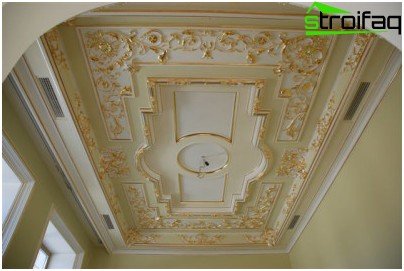
Rococo suspended ceiling: chic decor with gilded relief elements
Renaissance style features
Imitation of vaulted ceilings (multi-level construction) with smooth transitions of lines and painting in the center is typical for the design of the ceiling in the Renaissance style. The color scheme is restrained, only soft halftones, no contrasts. Also used are coffered ceilings, profiled cornices around the perimeter, stucco fragments.
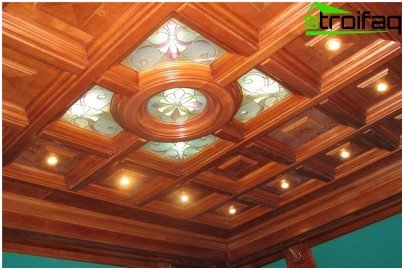
Renaissance coffered ceiling: multi-level design with painting in the center
Decorative slabs veneered with profile decorative slats (coffered ceilings) look very respectable, especially in combination with embossed additions, but the main requirement for arranging this type of suspended ceiling structure is a room height of about 3 m.
How to choose a color scheme
The warm colors of the modules (coffee, beige, orange, yellow, etc.) seem to most of us to be cozy, pleasing to the eye, but one important detail should be taken into account – warm shades “approximate” the surface. The ceiling will seem lower, especially if the surface is textured (under the skin, wood). Cold shades (snow-white, blue, azure, pink, gray) and a shiny or glossy surface visually distance the plane. Color transitions from dark at the edges to lighter in the center also visually raise the ceiling. Active color accents and a large pattern in the decoration of the ceiling are relevant for spacious rooms. In a small room, soft color transitions, a small pattern, the tone of the ceiling should be much lighter than the shade of the walls.
When choosing a design option for a suspended ceiling, take into account several important points: any shiny surface reflects and diffuses lighting, which in combination with light shades of the ceiling structure gives the effect of increasing space. The metallic luster of the modules accentuates the architecture. Try to avoid the combination of active color, complex texture, variety of decorative additions in the design of one ceiling. The more bizarre the form, the softer, more restrained the color combinations should be..
Designer photo collection



